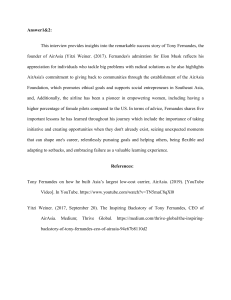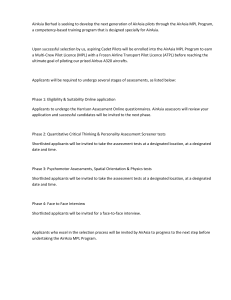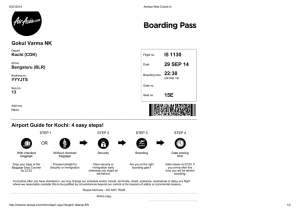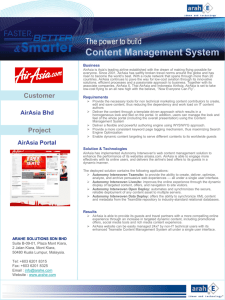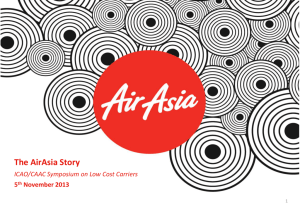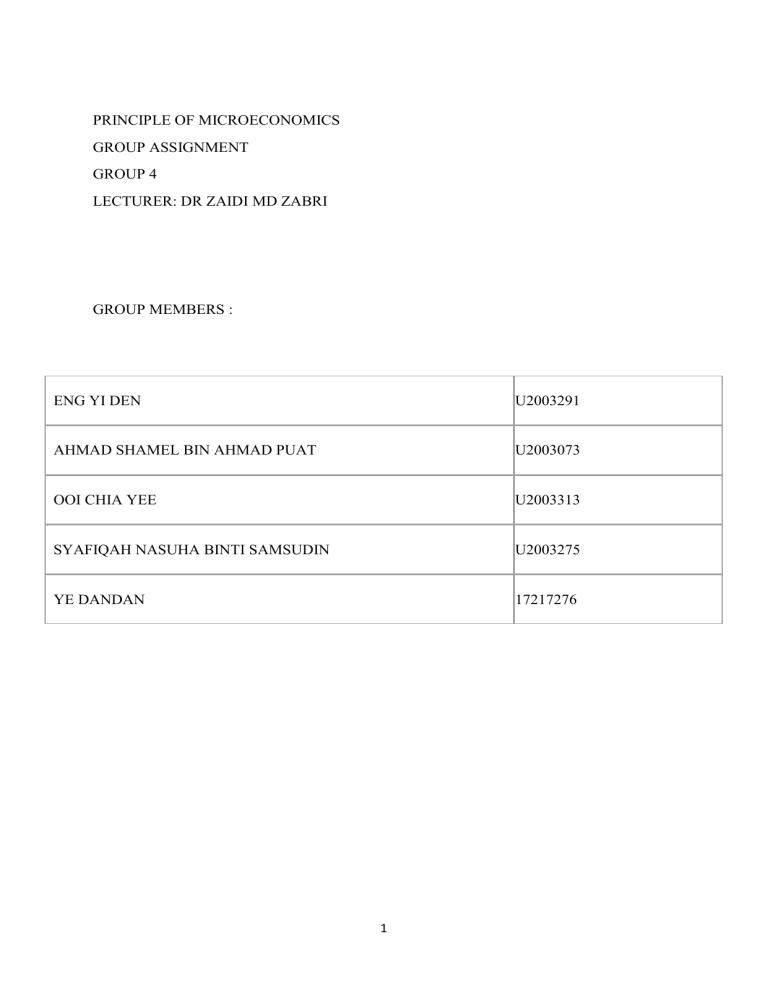
PRINCIPLE OF MICROECONOMICS GROUP ASSIGNMENT GROUP 4 LECTURER: DR ZAIDI MD ZABRI GROUP MEMBERS : ENG YI DEN U2003291 AHMAD SHAMEL BIN AHMAD PUAT U2003073 OOI CHIA YEE U2003313 SYAFIQAH NASUHA BINTI SAMSUDIN U2003275 YE DANDAN 17217276 1 1. AirAsia relies heavily on the new fleet of Airbus’ A330s. Explain how economic slowdown due to COVID-19 cause Airbus to change its output of A330s in the short run. Draw a graph to show the effect of movement control order (MCO) on AirAsia’s flight frequencies in the short run. In the short run, Airbus would reduce its output of A330s due to economic slowdown caused by COVID-19 mainly because the demand for aircraft A330s would be reduced. The whole aviation industry would be hard-hit by the fight against corona-virus. The key factor is a dramatic decline in tour and travels as a large number of both domestic and international flights are getting reduced and canceled, along with lock-down policies and travel restriction are being made by many governments, in order to restrain the transmission of the pandemic. According to Reuters, Malaysian AirAsia airline considered defer delivery of 78 Airbus A330 planes because of pandemic hit. That means aircraft manufacturers like Airbus will be harmed seriously. The significant drop of demand for A330s produced by Airbus is considered as a negative demand shock which Airbus is forced to cope with. The demand for A330s turned out to be lower than expected. The fleets of aircraft that could not sold may be put into warehouse. Therefore Airbus is forced to respond in the short run through cutback on output even layoffs to reduce losses. The graph to show effect of MCO on AirAsia flight frequencies in the short run are presented below: 2 The graph demonstrates how AirAsia are influenced by both supply and demand changes due to MCO in the short run, which can determine AirAsia’s flight frequencies change. The demand for AirAsia flights is decreased because passengers’ actions are strictly limited by MCO. MCO requires non-important companies to cease operations and public remain at home, reducing both domestic and international trips. Hence demand curve for AirAsia flights shifted to the left, from D1 to D2. The supply also decreased simultaneously, which means the frequencies of AirAsia fights are declined, because demand for the air trips is reduced sharply since people are working from home and starting quarantines due to MCO. Flights are being substantially reduced in China and other markets in North Asia, which account for large proportion of AirAsia flights, for the purpose of curbing spread of corona-virus. Therefore AirAsia are forced to provide fewer flights services in aviation industry, in other words, reduce frequencies of flights, which makes supply curve shifted to the left as well from S1 to S2. And the quantity demanded will change Q1 to Q2, which is the intersection of S2 and D2. In this case, both demand and supply decreased, there would also be a decrease in the equilibrium output for AirAsia in the short run. Because consumers want to purchase less and businesses want to supply less, so output would fall. This would be the effect of MCO to AirAsia’s flights in the short run. 3 2. One of the aftereffects of COVID-19 is the decline in oil prices. Explain why AirAsia might incur an economic profit (or loss) in the short run as the price of fuel declines. ANSWER: (BEFORE COVID-19) Price (P) AC P0 MC A MR=MC AR MR 0 Quantity (Q) Q0 AirAsia is oligopoly in market structure. One of the characteristics of the oligopoly market structure is very less of the company own more than half of the market share. For example, AirAsia own 41.2% of market share in the first quarter of 2019 while Malaysia Airline Berhad own 17.4% of market share during the same period. Thus, we can see that the total market share own by AirAsia and Malaysia Airline Berhad are over half of the total market share. We assume that before Covid-19 pandemic, AirAsia is facing a normal profit, where AirAsia is not facing any profit or loss. Based on the graph, equilibrium price fall on P0 while equilibrium quantity fall on Q0, where equilibrium point occurs when marginal revenue (MR) is equal to marginal cost (MC). All the average revenue (AR) is fully covering the average cost (AC) of AirAsia which total revenue (TR) equal to total cost (TC). P0AQ00 is the average cost of AirAsia and AirAsia is now facing a normal profit condition. 4 (AFTER COVID-19 PANDEMIC WHICH CAUSE THE DECLINE IN OIL PRICES) Price (P) MC AC P0 P1 A A1 MR=MC AR MR 0 Quantity (Q) Q0 Effects of COVID-19 decline in oil prices and causing the production costs of AirAsia to decrease. This cause the production cost of AirAsia decrease because AirAsia may spend less on oil costs while producing the same quantity supplied. Decreasing in production cost decrease causes the Average Cost (AC) curve to move downward from point A to Point A1. Based on the graph, 0P1A1Q0 is the new total cost of AirAsia while P00Q0A is the total revenue of AirAsia. Total revenue-total cost = profit or loss P00Q0A - 0P1A1Q0 = P0P1A1A (Profit) Therefore, P0P1A1A is the economic profit of AirAsia. AirAsia incur economic profit. 5 (REALITY) However, according to online news from Nikkei Asia, AirAsia suffers painful loss as COVID-19 pandemic spreads. Travel restrictions decrease the demand for air travel. Lowcost Southeast Asian carrier AirAsia Group illustrate 804 million ringgit ($188 million) firstquarter loss, compared to 96 million ringgit profit for the same period last year. Price (P) D0 S P0 E0 D1 D0 P1 E1 S 0 D1 Q1 Quantity (0) Q0 Based on the graph, market equilibrium falls on E0 when supply curve SS intersect with demand curve D0D0. Equilibrium price falls on P0 while equilibrium quantity falls on Q0. Due to Covid-19 pandemic and the travel restrictions by government, demand of AirAsia flight decrease and the curve of demand move downward to the left, forming D1D1. New market equilibrium falls on E1 when supply curve SS intersect with demand curve D1D1. New equilibrium price falls on P1 while new equilibrium quantity falls on Q1. We can see clearly that AirAsia economy suffer from a loss which due to the drastic decrease of flight demand although the decline in oil prices which may reduce the total cost for AirAsia. Thus, we may conclude that the demand is the main profit for AirAsia. Although the declines in prices of oil which may increase the profit earned, however, still insufficient to cover the loss by the demand, which is a large amount of money. QUESTION 3 : If some airlines decide to exit the aviation market due to COVID-19, explain how the remaining airlines' economic profit (or loss) will change. 6 ANSWER: (Before some airlines exit the aviation market) MC AC Price (P) P0 A AR E MR 0 Quantity (Q) Q0 Graph 3.0 The airlines industry is a oligopoly industry. Therefore, all company will gain a same profit which is normal profit because all airliner offer the same or just a little bit different price of airlines fees. As stated in the AVjob, all airlines have had the same estimating opportunity as companies in other businesses. Therefore, they react to both customer demand and the prices of competitors to set the fares and freight rates. Hence, this is why all airlines will get the normal profit or thin profit margin where the net profit only between one or two percent for most time and even at the best time. Based on the graph 3.0, the equilibrium point is at point E when the marginal revenue (MR) equal to marginal cost (MC) . The equilibrium price is at P0 and equilibrium quantity is at Q0. Average revenue (AR) is equal to average cost (AC) at P0AQ00. https://www.avjobs.com/history/airline-economics.asp 7 (After some airlines exit airlines market) MC AC Price (P) P0 P1 A B AR E MR 0 Quantity (Q) Q0 GRAPH 3.1 Due to this pandemic covid-19, airlines industry are one of the industry that hugely affected. From the interview with MAS Airlines by The Edge Market, MAS already had stuck with their financial before the pandemic. Indeed some time recently the widespread struck, MAS had gotten to be actually bankrupt within the monetary year finished December 31, 2018 (FYP2018), after liabilities surpassed its resources by RM852.14 million. If this case not be settle as soon as possible, in the long run MAS will exit the airlines industry. Therefore, Air Asia X (AAX) also had the same problem after it posted negative shareholders’ equity of RM864.1 million in the first. However, AAX had confident to remain in the industry where it refer to their operating statistics highlight the group’s path to recovery in the third quarter of 2020. It is shown when their passengers that carried by Air Asia Malaysia, Air Asia India and Air Asia Thailand had increased where the recorded improvement are from major domestic airline. While MAS future far less clear and the finance minister Tengku Zafrul Abdul Aziz had said that he would be leaving the future of Malaysia Airlines in the hands of sovereign wealth fund Khazanah. 8 Hence, it will give an advantages to the remaining airlines in the industry. As this is the oligopoly industry, the enter and exit company will happen. Due the pandemic, most company had been struggle to face this challenging time. If some airlines had decide to exit the aviation market, the advantages for remaining airlines is they will get more profit compared to before they just get a normal profit. Based on the graph 3.1, the equilibrium point is at E when MR is equal to MC. This situation had change the price from P0 to P1 while the quantity is still at Q0. Therefore, P0ABP1 is a profit that the remaining airlines will get after some airlines exit airlines market. 9 Question 4 Explain how the loss of high-paying jobs (e.g. flight officers, flight attendants, aircraft maintenance engineers) will affect local convenience stores' economic profit in Sepang (KLIA/ KLIA2) in the short run. Draw a graph to show the effects of the loss of high-paying jobs on local convenience stores' economic profit in the short run. Local convenience stores are category as monopolistic competition industry because most of the firms have their chain stores in all parts of a country and it is very competitive in the markets because there are too many firms. Since their products will be similar, so to rise above the others the price and the quantity of the products will be control. The local convenience stores which can get in Sepang (KLIA/KLIA2) are such as 7Eleven, KK Mart, Mynews.com, Family Mart, Xpress Mart and so on. Since all of them provide similar goods which can be substitutes by each other so the demand curve will be 10 very elastic. Usually, most of the demand of these local convenience stores are from the passengers of flights and also high-paying jobs. Due to the COVID-19 pandemic, many of high-paying jobs such as flight officers, flight attendants, aircraft maintenance engineers get lay off and indirectly this situation will affect the demand for the local convenience stores. When the demand decreases, the quantity of goods provide by local conveniences stores will be decrease too but still the price will not going to have any big changes because the demand curve for monopolistic competition industry are very elastic. In the short run, the local convenience stores still need to maximize their profit, so they will adjust the quantity of products and price according to the demand of the markets. For example, before the pandemic, local convenience stores can have output as much as Q0 and the price at P0 when the demand is D0. The profit that can get by the stores are A. After the pandemic and the loss of high-paying jobs happened, it will decrease the demand of the local convenience stores. When the demand D0 move to the left hand side which is D1 then the price will decrease to P1, so the profit will automatically decrease to B. This situation will lead the sales of the local conveniences store decrease and at the same time also increase the average cost of the products 11 REFERENCES Av Jobs Search (2020). Airline Economics. https://www.avjobs.com/history/airline-economics.asp Economic Impacts of COVID-19 on Civil Aviation. (n.d.-b). ICAO. https://www.icao.int/sustainability/Pages/Economic-Impacts-of-COVID-19.aspx J. Müller, (2020). Share of domestic routes by passengers in Malaysia 2018-2020.Retrieved October 2 2020. https://www.statista.com/statistics/954762/domestic-routes-market-share-malaysia/ Kang Siew Li (2020). Cover Story: Creditors to decide fate of MAS, AirAsia X. Retrieved October 22,2020 https://www.theedgemarkets.com/article/cover-story-creditors-decide-fate-mas-airasia-x MCGRAW-HILL EDUCATION . (2018). MC CONNELL BRUE FRYN ECONOMICS 21ST EDITION (2018).MCGRAW-HILL EDUCATION McCoy, D. (2020). Airbus cuts production rates in COVID-19 fallout. Wichita Business Journal. doi:https://www.bizjournals.com/wichita/news/2020/04/08/airbus-cuts-production-rates-in-covid19-fallout.html MONOPOLISTIC COMPETITION, DEMAND, AmosWEB Encyclonomic WEB*pedia, http://www.AmosWEB.com, AmosWEB LLC, 2000-2020 OpenStax. (n.d.). 10.1 Monopolistic Competition. Retrieved November 29, 2020, from https://opentextbc.ca/principlesofeconomics/chapter/10-1-monopolistic-competition/ P.Prem Kumar(2020). AirAsia suffers painful loss as COVID-19 crisis bites. Retrieved July 6,2020 https://asia.nikkei.com/Business/Travel-Leisure/AirAsia-suffers-painful-loss-as-COVID-19- Syahirah Syed Jaafar(2020). AirAsia confident of posting stronger results as international travel set to resume with Covid-19 vaccine, travel bubble progress .Retrieved November 17,2020 https://www.theedgemarkets.com/article/airasia-confident-posting-stronger-resultsinternational-travel-set-resume-covid19-vaccine 12 Tashny Sukumaran (2020). Can AirAsia and Malaysia Airlines stay aloft amid the coronavirus pandemic? Only with major restructuring, experts say. Retrieved November 23, 2020 https://www.scmp.com/week-asia/economics/article/3110741/can-airasia-and-malaysiaairlines-stay-aloft-amid-coronavirus 13
